Explore Innovative Cuisinart Pellet Grill Recipes
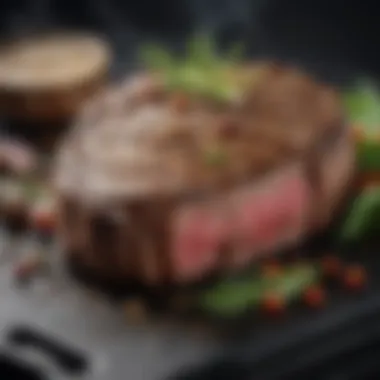
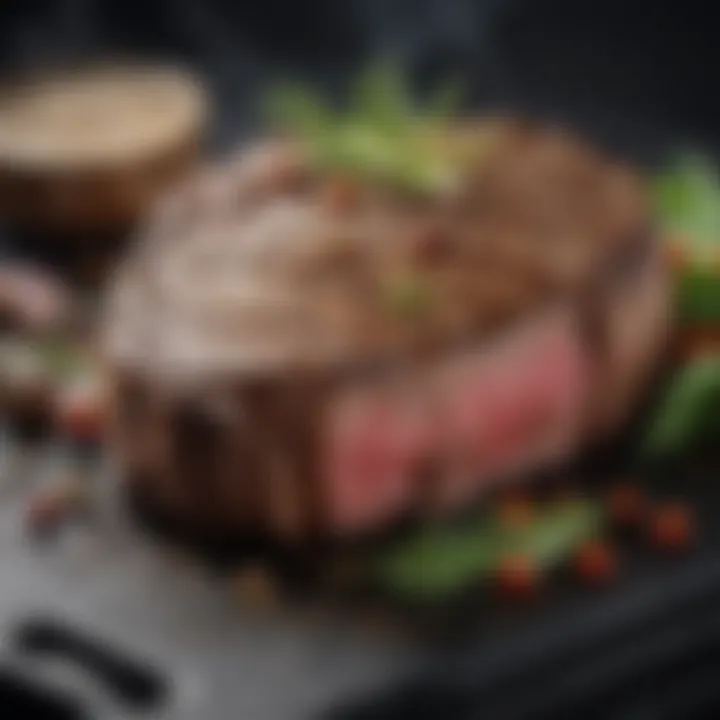
Intro
Cuisinart has established itself as a reputable brand in the realm of outdoor cooking, particularly with its range of pellet grills. Using wood pellets, these grills provide a unique blend of smoke and flavor, allowing for a variety of cooking methods such as grilling, smoking, and baking. This flexibility opens up endless possibilities to explore innovative recipes that go beyond traditional grilling.
In this article, readers will discover a wide array of recipes suitable for both novice cooks and experienced grill masters. Each recipe emphasizes flavor enhancement and cooking precision, addressing the nuances of using the Cuisinart pellet grill. Furthermore, this guide will cover the importance of ingredient pairings and meal planning, enabling food lovers to fully leverage their grilling potential. Preparing dishes outdoors not only brings a new dimension to flavors but also enhances the overall cooking experience and enjoyment.
Preface to Cuisinart Pellet Grills
In the expansive realm of outdoor cooking, Cuisinart pellet grills stand out for their innovative technology and culinary versatility. This segment seeks to provide an insightful entry point into understanding these remarkable cooking appliances and their role in enhancing your grilling experience. Pellet grilling merges the disciplines of both smoking and conventional grilling, leading to consistently well-prepared meals.
Understanding Pellet Grilling
Pellet grills operate by utilizing hardwood pellets made from compressed sawdust. The pellets are fed into a fire pot, where they ignite to create heat and smoke. This method allows for precise temperature control, making it easier for both beginners and veterans to achieve desired outcomes. Unlike traditional wood-burning grills, pellet grills deliver a more uniform cooking process, which is crucial for those transitioning from charcoal or gas grilling.
The pellet grill's control system often includes digital options that regulate the cooking temperature, ensuring that meats, vegetables, or any other culinary creation are cooked to perfection. By embracing the simplicity and effectiveness of using pellets, Cuisinart pellet grills democratize the art of cooking over fire, making it accessible to a wider audience.
Benefits of Pellet Grilling
Cuisinart pellet grills offer numerous advantages that reinforce their growing popularity:
- Consistent Temperature Control: Unlike other grilling methods, pellet grills maintain steady temperatures, which is essential for producing evenly cooked meats and dishes.
- Versatility: These grills are not limited to smoking. They can grill, bake, braise, or roast, enabling users to explore various cooking techniques.
- Flavor Enhancement: The choice of hardwood pellets allows grillers to experiment with different wood flavors, enhancing the taste profiles of numerous dishes. Options like hickory, mesquite, or applewood provide a myriad of flavor combinations.
- User-Friendly Design: The technology integrated into Cuisinart grills often includes digital displays and automated feed systems, making it simple even for less experienced chefs to operate.
"Pellet grills combine the best of both worlds: flavorful smoking and grilling, while still presenting ease of use and control."
By focusing on the fundamental aspects of pellet grilling, we set the stage for exploring innovative recipes and techniques, making it clear why Cuisinart pellet grills deserve a place in any culinary enthusiast's outdoor kitchen.
Getting Started with Cuisinart Pellet Grills
Starting with Cuisinart pellet grills can feel like a significant step in enhancing your culinary skills. These grills combine traditional grilling methods with innovation. You will find flexibility and ease of use in these pellet grills. Understanding their capabilities is essential for all levels of grilling enthusiasts.
Both novices and experienced chefs can benefit from learning the fundamentals of operating a pellet grill. The benefits include not only the ability to grill but also smoke, bake, and roast. This versatility makes the Cuisinart pellet grills an appealing option for diverse cooking styles.
Choosing the right model is a crucial first step. Likewise, knowing the appropriate tools and accessories can elevate your cooking experience. The right setup enhances efficiency and reduces the learning curve associated with using a new grilling system.
Choosing the Right Cuisinart Model
When considering a Cuisinart pellet grill, several models come into play. Each model offers unique features. Start by evaluating your needs and preferences. Are you cooking for a smaller household, or do you often host larger gatherings? The size of the cooking surface is a key factor.
In addition, think about features like digital controls and Wi-Fi capabilities. These technological enhancements provide convenience and precise temperature control, which are vital for achieving optimal cooking results. Check out the specifications and reviews for models such as the Cuisinart CPG-4000 and the Cuisinart CPG-6000 to make a well-informed choice.
Essential Tools and Accessories
Equipping yourself with the right tools and accessories can significantly improve your grilling experience. Essential items include grilling utensils like tongs, spatulas, and basting brushes that facilitate easier food handling. Moreover, a quality meat thermometer is crucial for ensuring your meat reaches the desired doneness.
Consider investing in a good wood pellet collection. Different wood types impart various flavors, so explore options like hickory, mesquite, or applewood. A high-quality pellet storage container is also important to keep pellets dry and ready for use.
Another recommended accessory is a grill cover. This helps protect the grill from weather elements, prolonging its life. Lastly, a grill light can provide visibility after sunset. With these tools and accessories, your journey with Cuisinart pellet grills can become not just easier, but also more enjoyable.
Starting the right way is crucial for success in every venture, including grilling. Analyze your needs and gear up appropriately.
Fundamental Techniques for Effective Grilling
Grilling is both an art and a science, especially when using a Cuisinart pellet grill. Mastering the fundamental techniques is essential for achieving flavorful and well-cooked dishes. The essence of effective grilling lies in three key areas: temperature control, wood pellet selection, and cleaning and maintenance. These techniques enhance not only the taste but also the overall grilling experience.
Temperature Control
Controlling the cooking temperature is crucial when using a Cuisinart pellet grill. Different foods require different temperatures for optimal cooking. Generally, lower temperatures are ideal for slow cooking or smoking, while higher temperatures are suited for searing and achieving a crisp exterior.
A good practice is to preheat the grill, allowing it to reach the desired temperature before placing food inside. This helps to ensure even cooking while locking in moisture. Also, consider using a grill thermometer for accuracy. This tool can assist in monitoring the internal temperature of the grill, which is vital, especially for meats, to ensure food safety. Proper temperature control reduces the risk of undercooking or overcooking – both of which can ruin a good meal.
Wood Pellet Selection
The choice of wood pellets plays a significant role in the overall flavor profile of grilled dishes. Cuisinart offers various types of wood pellets, each imparting its unique taste. For example, hickory pellets provide a strong, smoky flavor, ideal for red meats, while apple wood adds a fruitier note, perfect for chicken and pork.
Consider the food being prepared and select pellets that enhance its natural flavors. Here are a few common wood pellet options:
- Hickory: Rich and robust, best for red meat.
- Apple: Mild and sweet, complements poultry and pork.
- Mesquite: Intense and bold, suitable for barbecue dishes.
- Cherry: Subtle and sweet, works well with a variety of proteins.
Experimenting with different combinations of wood pellets can lead to exciting flavor discoveries.
Cleaning and Maintenance
Maintaining the Cuisinart pellet grill is fundamental to ensuring its longevity and performance. Regular cleaning prevents residue build-up, which can affect taste and affect the efficiency of the grill. Here are some essential practices for keeping your grill in top shape:
- Remove Ashes Regularly: Ashes accumulate after burning pellets, and too much can obstruct airflow. Clean the ash tray after every few uses.
- Clean the Grill Grates: Before and after use, scrape the grill grates to remove leftover food particles. A clean grill surface guarantees better flavor.
- Inspect the Drip Tray: The drip tray collects grease and other residue which should be cleaned after every few grilling sessions to avoid flare-ups.
- Monitor the Hopper: Ensure the pellet hopper is free from clogs and that the pellets are dry.
"Regular maintenance not only prolongs the life of your grill but enhances your cooking experience."
By focusing on these fundamental techniques—temperature control, wood pellet selection, and cleaning—you set the stage for successful grilling. Each step ensures that your Cuisinart pellet grill operates efficiently and delivers impressive flavors that will delight any palate.
Appetizing Appetizers for the Grill
Appetizers serve as the lovely gateway to a delicious meal. They set the tone for what follows and are often the most engaging part of a gathering. Cuisinart pellet grills, with their versatility, offer a medium that allows for creativity in appetizer preparation. Utilizing these grills for appetizers allows for the infusion of smoky flavors and makes them more indulgent.
Here, we explore two innovative recipes - Grilled Vegetable Skewers and Smoked Chicken Wings. Each recipe emphasizes distinct flavors and cooking techniques that resonate well with a wide audience.
Grilled Vegetable Skewers
Grilled vegetable skewers present a visually stunning appetizer that also is very healthful. The blending of different vegetables like bell peppers, zucchini, and cherry tomatoes adds vibrant colors, which can make any gathering festive. This dish is not only easy to prepare but also quick to cook, making it ideal for impromptu gatherings.
- Ingredients: Select a variety of vegetables to skew. Seasonal vegetables work best, and fresh herbs can enhance the taste significantly. For example, using marinated mushrooms or zucchini can elevate the dish.
- Preparation: Cut the vegetables uniformly so they cook evenly. Marinating them can add depth to the flavors. A simple marinade of olive oil, garlic, and herbs can enhance the taste without overwhelming it.
- Grilling: Keep an eye on them while grilling. It takes about 10 to 15 minutes on a medium heat setting. Rotate them for even cooking. The goal is to achieve a slightly charred exterior while maintaining a tender inside.
This appetizer shines due to its flexibility. Changing the vegetables or adding a spicy sauce can keep the experience new and exciting.


Smoked Chicken Wings
Chicken wings are undeniably a crowd-pleaser. When made in a Cuisinart pellet grill, they gain a unique flavor that frying or standard baking cannot replicate. The smoking process not only infuses flavor but also creates a tender texture that is often sought after.
- Ingredients: Choose fresh chicken wings. They can be seasoned simply with salt and pepper or marinated with spices. Common flavor profiles include barbecue, garlic, or Asian-inspired teriyaki. Aim for a balance of spices that complements the smokiness.
- Preparation: If marinated, let the wings soak for at least one hour before grilling. Patting them dry can help achieve a crispier skin when cooked. This can be an essential step if one prefers less oily wings.
- Grilling: Set the grill to a low temperature, around 225°F to 250°F, for the initial cooking phase. Smoke the wings for around 1 to 2 hours until they are thoroughly cooked. Increase the temperature to finish them off, creating that crispy outer skin. This method allows the flavors to develop beautifully, yielding a satisfactory texture and taste.
"The beauty of grilling appetizers like vegetable skewers and smoked wings is their ability to cater to both vegetarians and meat lovers, making them an excellent choice for diverse gatherings."
Delectable Main Courses to Try
In the realm of grilling, the main course often serves as the centerpiece of any meal. When using a Cuisinart pellet grill, you have the opportunity to prepare main courses that are not only visually appealing but also rich in flavor. The versatility of these grills lends itself well to a wide array of recipes that cater to various palates. Whether you prefer meat or vegetarian options, there is endless potential to elevate your grilling game.
The importance of delectable main courses cannot be overstated. They set the tone for the entire meal, enticing your guests and ensuring satisfaction. Moreover, preparing these dishes with precision using a pellet grill can enhance flavors through indirect cooking and smoke infusion, creating a depth that is difficult to achieve with traditional grilling methods.
Perfectly Grilled Steaks
Steaks are often the embodiment of the grilling experience. A perfectly grilled steak achieves a savory crust while maintaining a juicy interior. To accomplish this on a Cuisinart pellet grill, you must consider a few key factors:
- Quality of Meat: Always choose high-quality cuts, such as ribeye or filet mignon.
- Seasoning: Simple seasoning with salt and pepper works wonders, but marinating can add even more flavors.
- Temperature Control: Grilling at the right temperature ensures even cooking. Aim for a high sear followed by a lower temperature to finish.
Once these elements align, the magic happens. Grill the steak to your desired doneness, letting it rest afterward to optimize flavor and tenderness.
Barbecue Pulled Pork
Barbecue pulled pork presents another staple of the grill with its rich, smoky flavor. Achieving tender, shreddable pork requires both patience and the proper technique.
- Cut Selection: Use pork shoulder or butt, known for their fat content, which breaks down during cooking.
- Rub: Apply a dry rub consisting of brown sugar, paprika, salt, and cayenne for an excellent flavor profile.
- Low and Slow Cooking: Cook at a low temperature for several hours, allowing the wood pellets to infuse that quintessential smoky flavor.
After several hours, the pork will be tender and easily shredded with forks, perfect for sandwiches or served alongside coleslaw.
Vegetarian Stuffed Peppers
For those seeking a plant-based alternative, vegetarian stuffed peppers can be an exciting main course. They offer vibrant colors and flavors while remaining nutritious.
- Pepper Selection: Choose larger bell peppers for stuffing.
- Filling Options: A mixture of quinoa, black beans, corn, and spices creates a hearty filling that stands on its own.
- Grilling Technique: After stuffing, grill the peppers until tender. The smoke from the pellets adds a depth that enhances the overall dish.
These stuffed peppers are not only visually appealing but also provide a satisfying option for vegetarians and carnivores alike.
In summary, these delectable main courses provide a compelling reason to fire up your Cuisinart pellet grill. Each recipe invites creativity and experimentation, catering to a wide range of tastes and dietary needs.
Savory Side Dishes for Your Grill
Savory side dishes enhance any meal, especially when you're using a Cuisinart pellet grill. These accompaniments add texture, flavor, and a level of sophistication to your grilling experience. They round out your meals, making them more complete and enjoyable. Properly crafted side dishes can also elevate the main courses you serve.
When planning your grilling menu, consider the harmony between the main and side dishes. Think about how flavors and textures will interact. Savory sides can complement meats or vegetables, but they can also provide a balancing act against richer main dishes. This approach not only pleases the palate, but it also introduces variety and excitement into your meals.
Grilled Corn on the Cob
Grilled corn on the cob is a quintessential side dish that belongs on every grill. It is simple to prepare, yet it delivers an outstanding flavor. The sweet, crunchy kernels become slightly charred, adding depth and smokiness to the familiar taste of corn.
To grill corn effectively, start with fresh ears, preferably with the husks intact. Soaking the corn in water for about 30 minutes before grilling can help retain moisture during cooking. Once the corn is soaked, place it directly on the grill grates. Cook the corn for about 15 to 20 minutes, turning it occasionally for even cooking. The corn is done when it is tender and slightly charred.
You can enhance grilled corn by adding butter, salt, and a dash of chili powder, or even trying some grated cheese. The customization options are extensive. Options like lime juice, cilantro, or Parmesan can elevate it further.
Smoky Potato Wedges
Smoky potato wedges serve as another delightful addition to any grilling spread. Their crispy exterior, combined with a fluffy interior, makes them a satisfying side dish. Potatoes are versatile, and with a bit of creativity, the flavor profile can shift in many ways.
To prepare smoky potato wedges, begin with Russet potatoes or Yukon Gold for the best results. Cut the potatoes into wedges and soak them in cold water for 30 minutes to remove excess starch. This step allows them to crisp up nicely during grilling. After soaking, drain and dry them. Toss the wedges with olive oil, smoked paprika, garlic powder, and salt.
Once seasoned, place them on the grill over medium heat. Grill for about 30 minutes, turning occasionally until they become golden brown and crispy. These wedges provide a wonderful contrast when paired with grilled meats, while their smoky flavor ties them beautifully with the grilling theme.
Key takeaway: Side dishes like grilled corn on the cob and smoky potato wedges not only offer delicious flavors but also enhance the overall grilling experience, making meals memorable.
Complementary Sauces and Marinades
In the landscape of grilling, sauces and marinades are not just adjuncts; they are pivotal in shaping flavor profiles and enhancing the overall dining experience. Using a Cuisinart pellet grill opens avenues for diverse culinary expressions, and complementary sauces and marinades play a crucial role in this journey. A well-crafted sauce or marinade can accentuate the natural flavors of proteins and vegetables, adding depth and complexity.
The benefits of integrating sauces and marinades go beyond mere flavor enhancement. They also contribute moisture to grilled items, promoting a more tender texture. Moreover, the marinading process often imparts essential nutrients and develops a rich color that is visually appealing. Additionally, sauces can be used as finishing touches, providing a unique flair and personal touch. Considerations regarding ingredient choices and preparation methods can further refine the experience.
"A great sauce adds layers of flavor to grilled dishes, creating a taste that resonates even after the meal is over."
Homemade Barbecue Sauce
Creating your own homemade barbecue sauce is an enriching experience. It allows for full control over the ingredients and flavor dynamics. A classic barbecue sauce typically starts with a base of tomatoes, either in the form of ketchup or puree. From there, the addition of vinegar, sweeteners, and various spices creates a balanced flavor. Some versions incorporate smokey elements from chipotle or liquid smoke to enhance the grilled meats’ profile.
To make your own:
- Combine ketchup, apple cider vinegar, and brown sugar in a saucepan.
- Add Worcestershire sauce, garlic powder, onion powder, and smoked paprika.
- Simmer over low heat for about 20 minutes to meld flavors.
- Adjust seasoning according to taste, and enjoy the harmonious blend with your grilled dishes.
This homemade sauce not only elevates standard grilled meats but also provides a personal touch that readers can share with family and friends.
Herb Marinade for Grilled Proteins
Herb marinades are another essential component in the world of Cuisinart pellet grilling. These mixtures can work wonders for protein, infusing them with fresh, vibrant flavors. The base of an herb marinade usually includes a combination of olive oil, vinegar, and an assortment of fresh herbs such as parsley, rosemary, and thyme. The oil acts as a medium for flavor absorption and moisture retention, while the acidity from the vinegar helps in tenderizing.
To prepare an easy and effective herb marinade:
- In a bowl, whisk together olive oil, balsamic vinegar, and minced garlic.
- Add finely chopped herbs like basil, cilantro, and oregano.
- Season with salt and pepper.
- Marinade your proteins, ensuring even coverage, for at least 30 minutes before grilling.
This herb marinade not only enhances the flavors but also introduces a fresh aspect that complements the smoky character of the grill. Grilling with marinades like these can inspire creativity in the culinary process, pushing the boundaries of traditional grilling.
Desserts to Elevate Your Grilling Experience
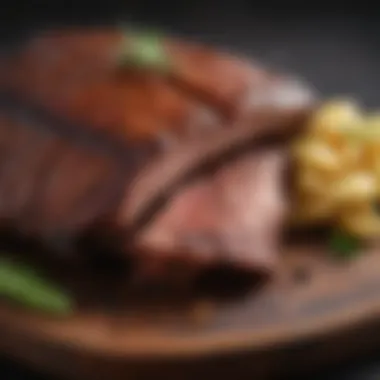
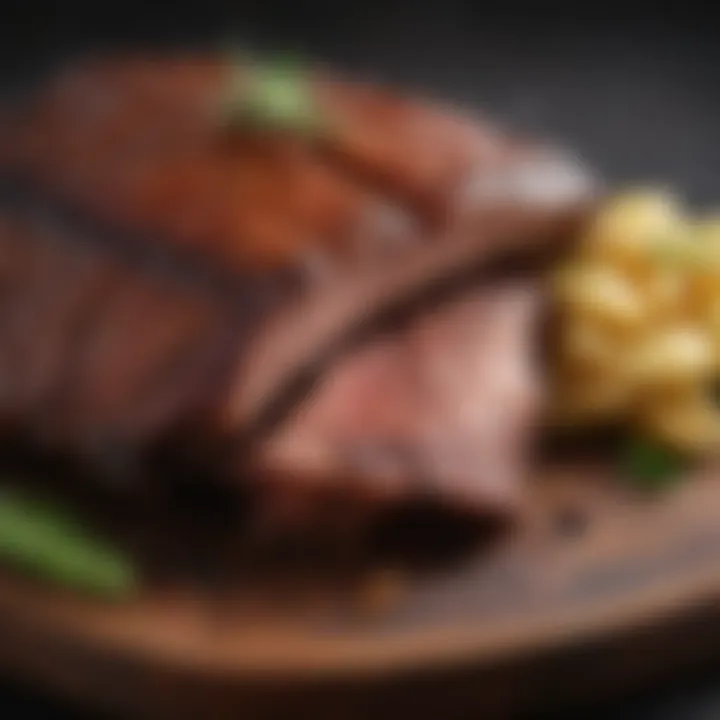
Grilling is not limited to main courses and sides; desserts can also play a crucial role in an outdoor cooking experience. Incorporating desserts into your pellet grilling repertoire not only showcases versatility but also provides an opportunity to tantalize the palate in unexpected ways. Grilled desserts can feature a delightful combination of caramelization and smokiness, enhancing flavors in a manner that traditional methods often miss.
Additionally, dessert offerings can create a sense of completion to a meal. They invite guests to linger and enjoy the moment. Using the unique capabilities of the Cuisinart pellet grill, one can explore new textures and flavors, transforming familiar favorites into show-stopping creations that are easy to prepare.
Grilled Peaches with Honey
Grilled peaches bring forth a juicy sweetness that reaches new heights when subjected to direct heat. The simple act of grilling can elevate the natural sugars present in peaches, resulting in a restaurant-quality dessert with minimal effort. Begin by selecting ripe yet firm peaches to prevent them from disintegrating on the grill.
Before grilling, slice the peaches in half and remove the pit. Brushing the cut sides with a blend of honey and a hint of cinnamon can further enhance the flavors during grilling. Place the peaches cut-side down on the grill and allow them to cook for about four to five minutes. The goal is to achieve grill marks and a soft, tender consistency without losing the fruit's shape.
Once off the grill, a drizzle of additional honey or even a sprinkle of sea salt can amplify the overall flavor. Pair with vanilla ice cream or whipped cream to create a delightful contrast of textures and temperatures. Grilled peaches thus provide a simple yet impactful way to finish a meal with elegance.
Smoked Chocolate Chip Cookies
Smoked chocolate chip cookies highlight the ability of the Cuisinart pellet grill to enhance classic recipes. The process begins with preparing your favorite chocolate chip cookie dough, using high-quality ingredients to ensure maximum flavor. Once the dough is ready, preheat your pellet grill to about 350°F.
Form the dough into balls and place them on parchment paper-lined baking sheets. Instead of the oven, place these sheets in the grill. The indirect heat ensures evenly baked cookies with a subtle smoky flavor.
After about 10 to 12 minutes, the cookies should be golden brown, and the rich aromas of melted chocolate will fill the air. Allow them to cool slightly before transferring to wire racks. The combination of smoky undertones with gooey chocolate is astonishing, offering a unique twist on an age-old favorite.
Nutritional Considerations
Understanding nutritional aspects is vital when grilling, especially with Cuisinart pellet grills. This consideration ensures that meals not only taste great but also contribute positively to health. By focusing on incorporating healthier ingredients and being aware of caloric content, grillers can create meals that are enjoyable and nutritious.
Incorporating Healthy Ingredients
When using a pellet grill, selecting fresh, whole ingredients can vastly improve the nutritional quality of your meals. Using lean meats, whole grains, and plenty of vegetables is a practical approach. For example, lean cuts of chicken or turkey provide high protein with lower fat content compared to fatty cuts of beef or pork. Moreover, grilling vegetables like bell peppers, zucchini, and asparagus enhances their flavor without the need for heavy sauces or oils. Incorporating herbs and spices instead of salt can give your dishes a flavor boost while minimizing sodium. Choose ingredients that are in season, as they are often more nutritious. Some ideas include:
- Fresh herbs such as basil or cilantro
- Seasonal fruit like peaches or pineapples
- Whole grain sides like quinoa or farro
By focusing on these healthy options, you promote the intake of essential vitamins and minerals, effectively making your grilling experiences both delicious and nourishing.
Caloric Awareness in Grilling
Caloric awareness is another critical element for those who grill. Understanding the caloric value of your ingredients helps in making informed choices. Many people do not realize that sauces and marinades can add significant calories to a meal. Opting for homemade sauces allows for better control of ingredients and caloric content. Generally, simple marinades with olive oil, vinegar, or citrus juices can add flavor without excessive calories. Additionally, avoiding pre-packaged, processed marinades can further aid in the reduction of unnecessary calories.
- Track portions: Being mindful of portion sizes also plays a role in caloric control. For instance, grilled chicken breast is nutritious, but consuming multiple servings can exceed daily caloric needs.
- Utilize food scales: Weighing food can provide a clearer understanding of portion sizes, helping maintain caloric goals.
Awareness of calories empowers grillers to enjoy their meals while aligning with health objectives. By making conscious decisions in ingredient selection and portion control, grilling can be both a fulfilling and healthful culinary experience.
By prioritizing nutrition in cooking, one can enjoy delicious food without sacrificing health.
Meal Planning and Preparation
Meal planning and preparation are essential aspects of utilizing a Cuisinart pellet grill effectively. It goes beyond merely deciding what to cook on a grill. This approach provides a structured way to optimize time, enhance flavor, and ensure that meals are balanced and enjoyable. By planning ahead, cooks can manage ingredients better, accommodate various dietary needs, and reduce food waste, all while simplifying the cooking process. The benefits are clear; organization leads to efficiency and creativity on the grill.
Strategizing Weekly Grilling Menus
When strategizing weekly grilling menus, consider the variety of flavors and textures you want to explore. A well-thought-out menu can help keep your grilling exciting. Here are key elements to consider:
- Diversity in Ingredients: Aim to incorporate proteins, vegetables, and grains that complement each other. For example, pairing grilled chicken with roasted seasonal vegetables brings freshness.
- Planning for Leftovers: Meals that yield leftovers can save time. For instance, grilled steak can become steak sandwiches the next day.
- Cooking for Occasions: Plan menus around social gatherings, ensuring the meals are suitable for your guests. Think about favorite recipes shared among friends and how these can be adapted for group servings.
Establish a rotation of recipes to prevent monotony. You might have a week where you focus on different styles, like Mexican grilling one week and Asian-inspired the next. This diversity keeps the meals enjoyable and fresh.
Batch Cooking for Efficiency
Batch cooking refers to preparing larger quantities of food in one go. This practice is beneficial for busy home cooks who still want to enjoy delicious grilled meals throughout the week. Below are considerations for successful batch cooking:
- Choose Freezable Items: Certain grilled dishes freeze well, so consider marinated meats, seasoned vegetables, or sauces that maintain their flavor quality. A dish like barbecue chicken can be prepped, cooked, and then stored in portions for later meals.
- Create Base Ingredients: Prepare common base ingredients, such as grilled vegetables or grains, and use them in various recipes. This technique allows you to experiment later in the week based on what else you might have on hand.
- Use Your Grill Efficiently: When you fire up your Cuisinart, cook as much as you can at once. This not only saves energy but also maximizes the flavor that comes from grilling in larger volumes.
Efficient meal preparation saves time and enhances your grilling experience, allowing you to enjoy the food without the pressure of constant cooking.
By integrating these strategies into your meal planning, you can elevate your culinary experience with the Cuisinart pellet grill. Preparing ahead means more time enjoying meals and less time stressing over them.
Exploring Global Influences in Grilling
The culinary world has vast diversity, and grilling is no exception to this norm. Exploring global influences in grilling allows cooks to broaden their horizons and apply techniques and flavors from different cultures. Each region brings unique ingredients and methods that can enhance outdoor cooking experiences. Understanding these global influences not only enriches the palate but also introduces creativity in meal preparation. It fosters appreciation for different cooking traditions, which can lead to a greater enjoyment of the process itself.
Southern U.S. Barbecue Techniques
Southern U.S. barbecue is renowned for its deep-rooted traditions and its prominence in American grilling culture. The techniques often developed from a combination of Native American, African, and European influences. Smoking is a primary technique, using hickory wood to impart a robust flavor.
Key elements of Southern barbecue include:
- Rub Selection: A dry rub, consisting of spices like paprika, garlic powder, and cayenne pepper, is typically massaged onto the meat before cooking. This enhances the flavor profile significantly.
- Low and Slow Cooking: Cooking at lower temperatures for extended periods is a hallmark of this style. It renders the fat and breaks down connective tissues. This results in tender and flavorful dishes.
- Sauce Variations: Southern barbecue sauces range from tangy vinegar-based sauces typical in North Carolina to sweeter tomato-based sauces found in Kansas City.
The art of Southern barbecue embodies a sense of hospitality and communal eating. Many families gather around a grill or smoker, sharing food and stories in a tradition deeply woven into the culture.
Asian Inspired Grilling Styles
Asian grilling styles reflect a spectrum of regional flavors, techniques, and cultural philosophies. They often focus on marinating meats and utilizing aromatic ingredients that create bold taste combinations.
Consider these features:
- Marinades: Asian marinades often consist of soy sauce, ginger, garlic, and sesame oil. The combination tenderizes the meat and infuses it with layers of flavor. For example, teriyaki marinade is popular for meats and vegetables alike.
- Grilling Techniques: Techniques such as rapidly cooking on high heat or indirect grilling are common. In regions like Korea, a popular method includes grilling meat at the table on a portable grill, blending social interaction and dining.
- Vegetable Grilling: Grilled vegetables, seasoned with miso or a sprinkle of sea salt, offer a refreshing contrast to grilled meats. They are often served as sides or incorporated into main dishes.
Asian grilling styles encourage exploration of diverse ingredients, combining the sweet, salty, sour, and umami flavors that define many Asian cuisines. Incorporating these techniques can elevate one's grilling game and provide a memorable culinary experience.
Troubleshooting Common Grilling Issues
Understanding common grilling issues is vital for any Cuisinart pellet grill user. Problems like temperature fluctuations and uneven cooking can adversely affect the outcome of your grilling endeavors. Correcting these issues not only enhances the quality of your meals but also improves your overall grilling experience. This section aims to provide practical solutions to these common problems, ensuring that you can grill confidently and consistently.
Combating Temperature Fluctuations
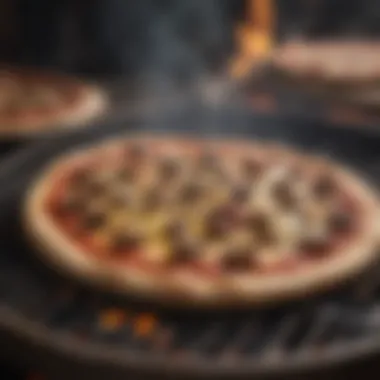
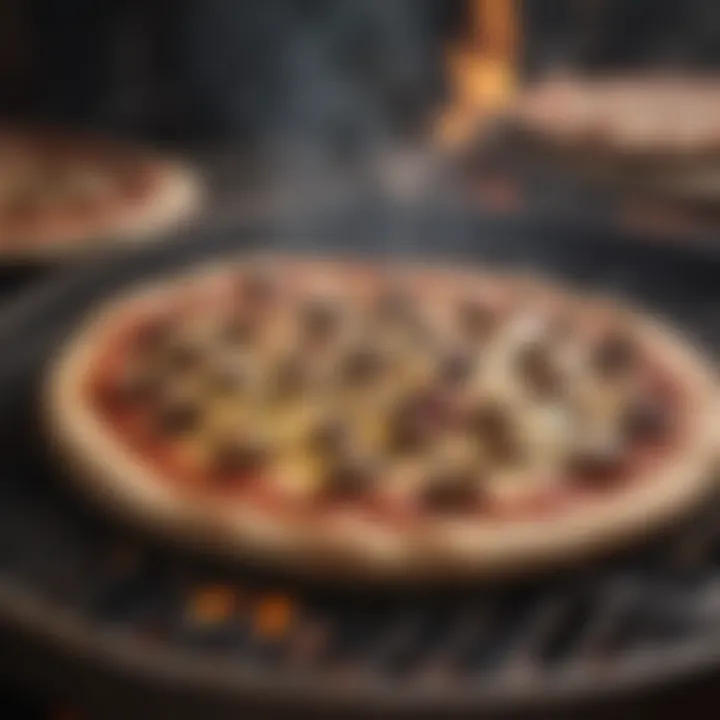
Temperature control is one of the key elements of successful grilling. Pellet grills, like those from Cuisinart, rely on a precise monitoring system to regulate heat. However, several factors can cause temperature fluctuations, such as external weather conditions and the quality of the pellets used.
To combat temperature fluctuations, consider the following tips:
- Use Quality Wood Pellets: Cheap or damp pellets can create inconsistent heat. Always opt for high-grade pellets to ensure steady temperatures.
- Avoid Opening the Lid Frequently: Each time the grill lid is opened, heat escapes, which can lead to temperature drops. Limit the amount you open the lid during cooking.
- Preheat the Grill: Ensure your grill is fully preheated before placing food on it. This stabilizes the cooking environment, allowing for even heat distribution.
- Check the Thermostat: Regularly check the grill's built-in thermometer against a reliable separate thermometer. If there's significant deviation, consider calibrating or replacing it.
Implementing these measures helps maintain a consistent cooking temperature. A stable temperature not only results in better cooking but also enhances flavor retention in your food.
Addressing Uneven Cooking
Uneven cooking is a common problem that can frustrate even the most experienced grillers. Various factors contribute to this issue, including hot spots in the grill, cooking methods, and the arrangement of food.
To ensure even cooking, follow these guidelines:
- Rotate Food on the Grill: Moving food items around ensures even exposure to heat. For instance, if one side of your grill tends to be hotter, you should rotate the meat or vegetables during cooking.
- Use a Meat Thermometer: Invest in a reliable probe thermometer to check the internal temperature of your meats. This is particularly important for thicker cuts, which may take longer to cook through.
- Understand Cooking Zones: Familiarize yourself with the specific hot and cooler zones of your grill. Arrange your food strategically; place food that needs longer cooking times towards the cooler areas and quicker-cooking items where it gets the most heat.
- Cook with the Lid Closed: Keeping the lid closed ensures that the heat circulates evenly inside the grill, contributing to more uniform cooking results.
By addressing these issues, you can transform your grilling game. Understanding temperature control and cooking techniques will lead to more consistent and enjoyable results in your outdoor cooking adventures.
"Consistency is the key to mastering the grill; understanding the nuances of your equipment will lead to greater culinary triumphs."
Remember, practice makes perfect. The more you grill, the more familiar you become with your Cuisinart pellet grill's behavior.
Safety Protocols for Pellet Grilling
Safety is paramount when using any grilling equipment, and pellet grills are no exception. Ensuring proper safety protocols can prevent accidents and enhance the overall grilling experience. Understanding these protocols not only protects cooks and their guests but also safeguards the equipment itself. This section emphasizes the crucial safety practices for pellet grilling, highlighting fire safety and proper handling techniques with hot equipment.
Fire Safety Tips
Fire safety is the cornerstone of any outdoor cooking activity. When using a Cuisinart pellet grill, here are important considerations:
- Clear the Area: Ensure that the grilling area is free of flammable materials like paper, cloth, or dry leaves. Establish a safe perimeter to keep guests at a distance while grilling.
- Monitor the Grill: Never leave the grill unattended, especially when in use. Ongoing observation allows for quick response to any unexpected scenarios.
- Know Your Grill: Familiarize yourself with the location of the fire extinguisher. Understanding how the grill operates, including how to turn it off, is fundamental in an emergency.
- Use Quality Pellets: Low-quality pellets may contain excessive chemicals or additives that can lead to hazardous flare-ups. Opt for recognized brands that meet safety standards.
- Maintain Ventilation: Grilling outdoors should ensure good airflow. Avoid using the grill in enclosed spaces, as this can lead to carbon monoxide buildup.
Following these guidelines creates a safer environment for all involved while enjoying the grill's advantages.
Proper Handling of Hot Equipment
Handling hot equipment requires a systematic approach to prevent burns or accidents. Here are key practices:
- Wear Protective Gear: Use heat-resistant gloves designed for grilling. Avoid wearing loose clothing that could catch fire or come into contact with hot surfaces.
- Keep Tools Handy: Gather all necessary grilling tools before starting up the grill. Having items like spatulas, tongs, and brushes at arm's reach minimizes the need to move away from the grill while it's hot.
- Use Proper Lifting Techniques: When lifting grill covers or transferring food, utilize tools designed for heat. Always check the temperature of surfaces before placing hands near them.
- Let Equipment Cool Down: After grilling, allow the equipment to cool down completely before cleaning or storing it. This prevents injury and prolongs the grill's life.
- Educate Others: If grilling with friends or family, share these practices to ensure everyone understands the risks involved and knows how to act safely.
Implementing these safety protocols not only enhances the grilling experience but also establishes a culture of responsibility for the activity. By minimizing hazards related to fire and heat, cooks can focus on creating delicious meals with confidence.
Environmental Considerations
Environmental considerations play a crucial role in contemporary grilling practices, particularly when utilizing a Cuisinart pellet grill. The awareness surrounding ecological footprints is rising among consumers who appreciate not just taste but also sustainability in their cooking methods. By focusing on environmentally friendly practices, grillers can contribute positively to the planet while enjoying the art of outdoor cooking.
Sustainable Pellet Sourcing
One significant aspect of environmentally conscious grilling is sustainable pellet sourcing. The wood pellets used in Cuisinart grills should come from forests that are managed responsibly. Using pellets produced from waste wood or sawdust not only reduces waste but also ensures less impact on deforestation. Consumers should look for pellets certified by organizations like the Forest Stewardship Council (FSC).
Additionally, sourcing wood pellets locally can lessen transportation emissions, promoting an overall efficient supply chain. It is worth noting that not all pellets are created equal; hence, choosing those from sustainable, renewable sources adds a layer of ethical consideration to the grilling experience.
Minimizing Carbon Footprint in Grilling
Reducing the carbon footprint while grilling is another essential factor. The environmental impact associated with outdoor cooking can be substantial, but thoughtful approaches can significantly mitigate these effects. One method includes optimizing the usage of pellets. Minimizing wasted heat through proper settings can decrease the number of pellets needed. Furthermore, maintaining the grill minimizes excess smoke and harmful emissions emitted into the atmosphere.
Another approach is to focus on eco-friendly grilling practices. Utilizing natural lighter fluids or electric igniters instead of chemical ones can contribute to a cleaner grilling experience. Additionally, preparing meals that require less cooking time can further reduce energy consumption.
In essence, integrating these environmental considerations into grilling not only enhances the experience but also brings a sense of responsibility and knowledge to a community passionate about culinary innovation. By choosing sustainable practices, grill owners do their part to protect the environment for future generations.
Innovations in Pellet Grilling Technologies
The realm of pellet grilling is evolving rapidly, shaping how enthusiasts approach outdoor cooking. Innovations in this technology significantly enhance the grilling experience, ensuring consistent results and improved flavor profiles. As more people embrace pellet grills, understanding the latest advancements becomes critical.
One key aspect is the emergence of smart grilling devices. These devices integrate technology with traditional grilling. Smart grills enable users to monitor cooking temperatures and times remotely, often through a smartphone app. This feature allows for precise adjustments, minimizing the risk of overcooking or burning food. Users can set alerts for when food reaches a specific temperature, enabling multitasking without compromising on results. The convenience offered by these devices facilitates a more relaxed grilling experience, particularly for those with busy schedules.
In addition to smart devices, there are advancements in pellet quality that cannot be overlooked. The wood pellets used in grilling significantly influence flavor and performance. Modern innovations focus on enhancing the efficiency and consistency of pellets. Manufacturers are experimenting with different wood blends and pressing techniques to produce pellets that burn cleaner and provide a more uniform heat. Improved pellet quality not only elevates the taste of grilled foods but also contributes to better overall grill performance.
These technological innovations make cooking with a Cuisinart pellet grill a reliable option. They allow both novice and experienced grillers to experiment with flavors and techniques while maintaining an effortless cooking process. As the industry advances, staying informed about these innovations ensures that users can optimize their outdoor culinary experiences.
Finale: The Versatility of Cuisinart Pellet Grills
The versatility of Cuisinart pellet grills stands as a key theme throughout this article. These grills not only offer a means to cook but provide a platform for creativity and experimentation. Their functionality ranges from smoking to baking and roasting, catering to a wide array of culinary preferences. This adaptability is essential for cooks at any level, allowing for a comprehensive exploration of flavors and techniques that can be utilized year-round.
Primarily, Cuisinart’s innovative pellet grill technology ensures precise temperature control. This translates into consistent results, whether grilling meats, baking desserts, or smoking vegetables. As the temperature can be easily adjusted, it leads to better cooking outcomes and enhances the flavor of the food prepared. Additionally, by utilizing high-quality wood pellets, the essence of smoke integrates beautifully with marinades and spices, elevating even basic recipes.
Moreover, these grills facilitate outdoor cooking on a larger scale, making them ideal for gatherings and family meals. The easy-to-use features transform the grilling experience into a communal activity where individuals can bond over food preparation. As grilling gains popularity, Cuisinart supports this trend with equipment designed to inspire culinary adventures.
In summary, the advantages presented by Cuisinart pellet grills not only simplify the cooking process but enrich it. The ability to create unique meals tailored to individual tastes and preferences reinforces the appeal of these grills. This versatility is not only a practical benefit but also enhances the joy of culinary exploration.
Reflections on Grilling Techniques
As we reflect on various grilling techniques discussed in this article, it is clear that mastering these skills can redefine one’s culinary journey. The handling of temperature control, selection of wood pellets, and understanding of marinade applications are fundamental to grill success. Each technique contributes to the overall flavor profile of the dish, ensuring that every cooking session can yield impressive results.
Many grilling techniques have evolved over the years, combining traditions from various regions into contemporary practices. For instance:
- Smoking: Enhances the flavor through slow cooking with wood smoke.
- Direct grilling: Good for high-temperature searing of meats or vegetables.
- Indirect grilling: Allows slower cooking for larger cuts, resulting in tenderness.
These methods offer distinct paths to culinary excellence. By understanding and applying these techniques, home cooks can gain confidence in using their Cuisinart pellet grills to create mouthwatering dishes that reflect their personal tastes.
Encouragement for Culinary Experimentation
The encouragement of culinary experimentation creates an exciting atmosphere in the world of grilling. Cuisinart pellet grills serve as the perfect medium for trying new recipes. The combination of varying wood pellets and adjustable temperatures jumps into the creative choices a cook can make. There are no rigid rules in grilling; rather, the objective is to enjoy the process and to savor the results.
Among the ways to experiment are:
- Combining flavors: Try blending different marinades and spices from various cuisines to create unique taste combinations.
- Innovative pairings: Pair meats with unexpected fruits or vegetables. For example, smoked apples can add sweetness to pork dishes.
- Technique exploration: One could alternate between smoking and grilling methods, noting how they alter the flavor and texture of the food.
"Culinary creativity thrives on experimentation. Don’t be afraid to make mistakes; they often lead to delicious discoveries."
Ultimately, this spirit of innovation is crucial for any avid griller. The Cuisinart pellet grill offers a platform that makes it both accessible and enjoyable to push the boundaries of traditional cooking. Encouragement for this kind of experimentation can lead to expanded skill sets and ultimately, a greater appreciation for the art of grilling.







